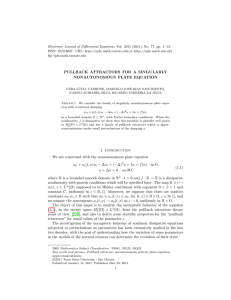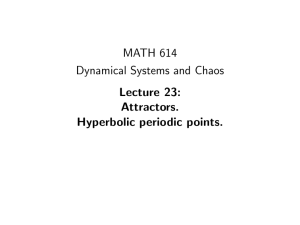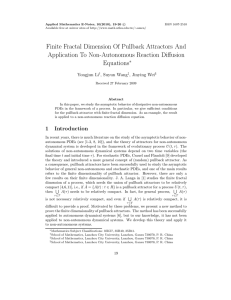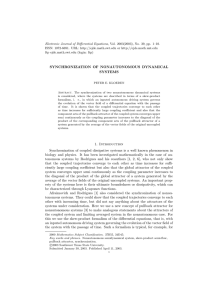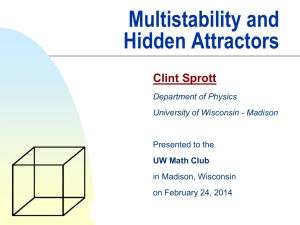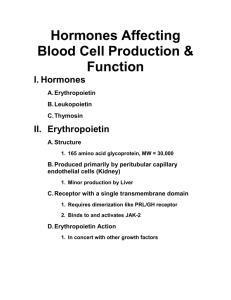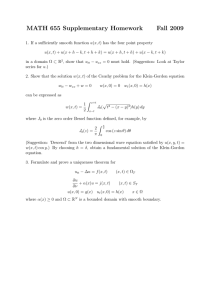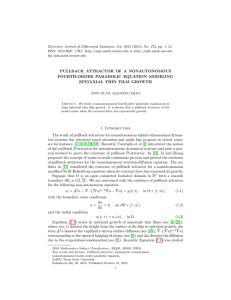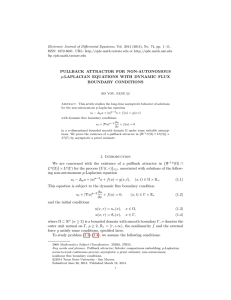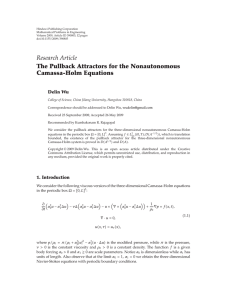Electronic Journal of Differential Equations, Vol. 2012 (2012), No. 185,... ISSN: 1072-6691. URL: or
advertisement
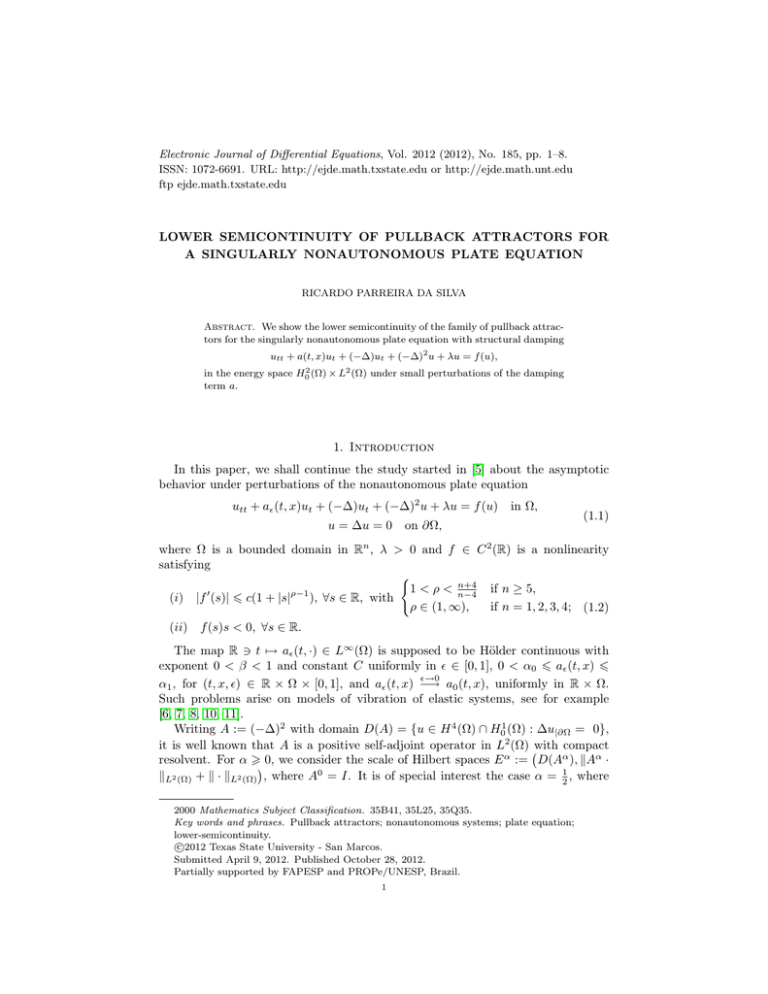
Electronic Journal of Differential Equations, Vol. 2012 (2012), No. 185, pp. 1–8.
ISSN: 1072-6691. URL: http://ejde.math.txstate.edu or http://ejde.math.unt.edu
ftp ejde.math.txstate.edu
LOWER SEMICONTINUITY OF PULLBACK ATTRACTORS FOR
A SINGULARLY NONAUTONOMOUS PLATE EQUATION
RICARDO PARREIRA DA SILVA
Abstract. We show the lower semicontinuity of the family of pullback attractors for the singularly nonautonomous plate equation with structural damping
utt + a(t, x)ut + (−∆)ut + (−∆)2 u + λu = f (u),
in the energy space H02 (Ω) × L2 (Ω) under small perturbations of the damping
term a.
1. Introduction
In this paper, we shall continue the study started in [5] about the asymptotic
behavior under perturbations of the nonautonomous plate equation
utt + a (t, x)ut + (−∆)ut + (−∆)2 u + λu = f (u)
u = ∆u = 0
in Ω,
on ∂Ω,
(1.1)
where Ω is a bounded domain in Rn , λ > 0 and f ∈ C 2 (R) is a nonlinearity
satisfying
(
n+4
if n ≥ 5,
1 < ρ < n−4
0
ρ−1
(i) |f (s)| 6 c(1 + |s| ), ∀s ∈ R, with
ρ ∈ (1, ∞),
if n = 1, 2, 3, 4; (1.2)
(ii) f (s)s < 0, ∀s ∈ R.
The map R 3 t 7→ a (t, ·) ∈ L∞ (Ω) is supposed to be Hölder continuous with
exponent 0 < β < 1 and constant C uniformly in ∈ [0, 1], 0 < α0 6 a (t, x) 6
→0
α1 , for (t, x, ) ∈ R × Ω × [0, 1], and a (t, x) −→ a0 (t, x), uniformly in R × Ω.
Such problems arise on models of vibration of elastic systems, see for example
[6, 7, 8, 10, 11].
Writing A := (−∆)2 with domain D(A) = {u ∈ H 4 (Ω) ∩ H01 (Ω) : ∆u|∂Ω = 0},
it is well known that A is a positive self-adjoint operator in L2 (Ω) with compact
resolvent. For α > 0, we consider the scale of Hilbert spaces E α := D(Aα ), kAα ·
kL2 (Ω) + k · kL2 (Ω) , where A0 = I. It is of special interest the case α = 21 , where
2000 Mathematics Subject Classification. 35B41, 35L25, 35Q35.
Key words and phrases. Pullback attractors; nonautonomous systems; plate equation;
lower-semicontinuity.
c
2012
Texas State University - San Marcos.
Submitted April 9, 2012. Published October 28, 2012.
Partially supported by FAPESP and PROPe/UNESP, Brazil.
1
2
R. P. SILVA
EJDE-2012/185
−A1/2 is the Laplace operator with homogeneous Dirichlet boundary conditions;
i.e., A1/2 = −∆ with domain E 1/2 = H 2 (Ω) ∩ H01 (Ω).
Setting the Hilbert space X 0 := E 1/2 × E 0 , let A (t) : D(A (t)) ⊂ X 0 → X 0 be
defined by
0
−I
A (t) :=
,
A + λI A1/2 + a (t)I
with domain D(A (t)) := E 1 × E 1/2 (independent on t and ). We also define
α+1
α
X α := E 2 × E 2 .
In this framework was shown in [5] that the problem (1.1) can be written as an
ordinary differential system
d
(u, v) + A (t)(u, v) = F ((u, v)),
dt
(u(τ ), v(τ )) = (u0 , v0 ) ∈ X 0 , t > τ ∈ R, (1.3)
where F ((u, v)) = (0, f e (u)) and f e is the Nemitskiĭ operator associated to f . This
equation yields an evolution process {S (t, τ ) : t > τ } in X 0 which is given by
Z t
S (t, τ )x = L (t, τ )x +
L (t, s)F (S (s, τ )x) ds, ∀t > τ ∈ R, x ∈ X 0 , (1.4)
τ
being {L (t, τ ) : t > τ ∈ R} the linear evolution process associated to the homogeneous system
d
(u, v) + A (t)(u, v) = (0, 0), (u(τ ), v(τ )) = (u0 , v0 ) ∈ X 0 , t > τ.
(1.5)
dt
Furthermore the evolution process {S (t, τ ) : t > τ } has a pullback attractor
{A (t) : t ∈ R} with the property that
∪∈[0,0 ] ∪t∈R A (t) ⊂ X 0 is bounded.
(1.6)
Recalling the Hausdorff semi-distance of two subsets A, B ⊂ X
dist H (A, B) := sup inf ka − bkX 0 ,
a∈A b∈B
also was shown the upper semicontinuity of the family {A (t) : t ∈ R} at = 0; i.e.,
→0
dist H (A (t), A0 (t)) −→ 0.
Our aim in this paper is to prove its lower semicontinuity at = 0; i.e.,
→0
dist H (A0 (t), A (t)) −→ 0.
To achieve this propose we proceed in the following way: We assume there exists
only a many finite number of equilibrium e∗ of (1.3), all of them hyperbolic in
the sense that the linearized operator of (1.3) around e∗ admits an exponential dichotomy. Then we write the limit attractor as an unstable manifold of the equilibria
set, allowing us to obtain the lower semicontinuity as in [3].
This article follows closely [1, 2], and it is organized as follows: In Section 2 we
derive some additional stability properties of the solutions starting in the pullback
attractors. In Section 3 we get the characterization of the pullback attractor as a
unstable manifold of the equilibria set, and in Section 4, we show the hyperbolicity
property of the equilibria of (1.1) and we derive the lower semicontinuity of the
pullback attractors.
EJDE-2012/185
LOWER SEMICONTINUITY OF PULLBACK ATTRACTORS
3
2. Stability of the process on the attractor
In this section we prove an asymptotically stability result of the evolution processes starting on the attractors. First we recall from (1.6) that
{A (t) : t ∈ R} = {ξ ∈ C(R, X 0 ) : ξ is bounded and S (t, τ )ξ(τ ) = ξ(t)}.
Therefore if ξ(t) ∈ A (t) for all t ∈ R, then
Z
t
ξ(t) := (u(t), ut (t)) = L (t, τ )ξ(τ ) +
L (t, s)F (ξ(s)) ds,
τ
and by the exponential decay of L (t, τ ) [5, Theorem 3.1], we can write
Z t
ξ(t) =
L (t, s)F (ξ(s)) ds.
(2.1)
−∞
For w0 = ξ(τ ) fixed, consider
Z
t
U (t, τ ) := (w(t), wt (t)) =
L (t, s)F (S (s, τ )w0 ) ds,
τ
and note that
wtt + a (t, x)wt + (−∆)wt + (−∆)2 w + λw = f (u(t, τ, w0 )),
w(τ ) = wt (τ ) = 0.
(2.2)
Also notice that by [5, Theorem 3.2], {U (t, τ ) : t > τ } is a bounded subset of
X 0 . Therefore using the fact that f e maps bounded subsets of E 1/2 to bounded
1
subsets of E − 2 +γ̃ , for some γ̃ > 0 [5, Lemma 2.5], we can state the problem (1.3)
1
1
in X 2γ = E 2 +γ × E γ with 0 < γ < γ̃ (note that U (0, 0) = (0, 0) ∈ E 2 +γ × E γ ),
and we have [4] the estimate
Z t
kU (t, τ )kX 1+2γ 6
kL (t, s)kL(X 1+2γ ,X −1+2γ̃ ) kF (S (s, τ ))w0 k 12 +γ − 12 +γ ds
×E
E
τ
Z t
6K
(t − s)−1+2γ̃−2γ e−α(t−s) ds.
τ
Noticing that −1 + 2γ̃ > −1, from (2.1) it follows that
sup sup sup kξ(t)k
1
E 2 +γ ×E γ
∈[0,1] t∈R ξ∈A (t)
< ∞.
cc
1
From the compact embedding E 2 +γ × E γ ,→ E 1/2 × E 0 , the set ∪∈[0,1] ∪t∈R A is
a compact subset of X 0 .
The rest of the section is dedicated to show asymptotically stability of those
solutions starting on the attractors. Since the map t 7→ a0 (t, x) is a bounded and
Lipschitz function uniform in x ∈ Ω, given a sequence {tn } ⊂ R, we have for each t ∈
R fixed, that the sequence {an (t, x) := a0 (t + tn , x)} has a subsequence convergent
an (t, x) → ā(t, x), uniformly in compact subsets of R and x ∈ Ω. Therefore ā
inherits the same boundedness and Lipschitz properties of a0 . This allows us to
consider the following two problems:
utt + an (t, x)ut + (−∆)ut + (−∆)2 u + λu = f (u)
u = ∆u = 0
2
u(τ ) = u0 ∈ H (Ω) ∩
H01 (Ω),
in Ω,
on ∂Ω,
(2.3)
2
ut (τ ) = v0 ∈ L (Ω),
4
R. P. SILVA
EJDE-2012/185
and
utt + ā(t, x)ut + (−∆)ut + (−∆)2 u + λu = f (u)
u = ∆u = 0
u(τ ) = u0 ∈ H 2 (Ω) ∩ H01 (Ω),
in Ω,
on ∂Ω,
(2.4)
ut (τ ) = v0 ∈ L2 (Ω).
We want to compare solutions of the above problems with initial data (u0 , v0 ) ∈
An (τ ), where {An (t) : t ∈ R} and {A∞ (t) : t ∈ R} are the pullback attractors of
(2.3) and (2.4) respectively. Proceeding as above we obtain that
∪n∈N ∪t∈R An (t) ∪ A∞ (t) is a compact subset of X 0 .
¯ be the solutions of (2.3) and (2.4) respecFor (u0 , v0 ) ∈ An (τ ), let ξn (t) and ξ(t)
¯
tively. Defining w(t) := ξn (t) − ξ(t), we have
¯
wtt = ā(t, x)ξ¯t − an (t, x)ξt + ∆wt − ∆2 w − λw + f (ξ) − f (ξ)
w(τ ) = wt (τ ) = 0.
(2.5)
Define Z(u, v)) = 21 (kuk21/2 + kvk2L2 (Ω) ). Since that f e is Lipschitz in bounded
¯ ξt , ξ¯t are bounded, Young’s Inequality leads to
sets from E 1/2 to E 0 , and ξ, ξ,
d
Z((w, wt ))
dt
= hw, wt iE 1/2 + hwt , wtt iL2 (Ω)
= h∆w, ∆wt iL2 (Ω) + λhw, wt iL2 (Ω) + hwt , wtt iL2 (Ω)
= h∆2 w + λw + wtt , wt iL2 (Ω)
¯ wt iL2 (Ω)
= hā(t, x)ξ¯t − an (t, x)ξt + ∆wt + f (ξ) − f (ξ),
= h−ā(t, x)wt + (ā(t, x) − an (t, x))ξt , wt iL2 (Ω) − k∇wt k2L2 (Ω)
¯ wt iL2 (Ω)
+ hf (ξ) − f (ξ),
6 −α0 kwt k2L2 (Ω) + kā − an kL∞ ([τ,t]×Ω) kξt kL2 (Ω) kwt kL2 (Ω)
+ K(kwk2L2 (Ω) + kwt k2L2 (Ω) )
6 K̃Z((w, wt )) + K̃kā − an kL∞ ([τ,t]×Ω) .
Therefore,
Z
t
Z((w(s), wt (s)))ds + K̃(t − τ )kā − an kL∞ ([τ,t]×Ω)
+ Z (w(τ ), wt (τ ))
Z t
˜
˜ − τ )kā − a k ∞
6 K̃
Z((w, wt ))ds + K̃(t
n L ([τ,t]×Ω) ,
Z((w, wt )) 6 K̃
τ
τ
˜ = max K̃, Z((w(τ ),wt (τ ))) . Gronwall’s Inequality yields
where K̃
(α1 −α0 )
˜˜
¯ 2 0 6 K̃kā
kξn (t) − ξ(t)k
− an kL∞ ([τ,t]×Ω)
X
Z
τ
as n → ∞ in compact subsets of R.
t
eK(t−s) ds → 0,
(2.6)
EJDE-2012/185
LOWER SEMICONTINUITY OF PULLBACK ATTRACTORS
5
3. structure of the pullback attractor
We will assume that there exist only finitely many {u∗1 , . . . , u∗r } solutions of the
problem
(−∆)2 u + λu = f (u) in Ω,
(3.1)
u = ∆u = 0 on ∂Ω,
Defining E = {e∗1 , . . . , e∗r }, where e∗i := (u∗i , 0), we will show that
A0 (t) = ∪ri=1 W u (e∗i )(t),
for all t ∈ R,
(3.2)
where
W u (e∗i ) = (τ, ζ) ∈ R × X 0 : there exists a backwards solution ξ(t, τ, ζ) of (1.3)
t→−∞ ( = 0) satisfying ξ(τ, τ, ζ) = ζ and kξ(t, τ, ζ) − e∗i kX 0 −→ 0 ,
and W u (e∗i )(t) = {ζ ∈ X 0 : (t, ζ) ∈ W u (e∗i )}.
Consider the norms in E 1/2 and X 0 given respectively by:
kuk1/2 := [k∆uk2L2 (Ω) + λkuk2L2 (Ω) ]1/2 and k(u, v)kX 0 = [kuk21/2 + kvk2L2 (Ω) ]1/2 .
For any 0 < b 6 1/4 fixed we have
1
3
1
k(u, v)k2X 0 6 k(u, v)k2X 0 + 2bλ1/2 hu, viL2 (Ω) 6 k(u, v)]k2X 0 .
4
2
4
0
Let us consider the Lyapunov functional V : X → R defined by
Z
1
V ((u, v)) = k(u, v)k2X 0 + 2bλ1/2 hu, viL2 (Ω) −
F e (u) dx,
(3.3)
2
Ω
Rs
where F e is the Nemitskiĭ map associated to a primitive of f , F(s) = 0 f (t) dt.
If u = u(t) is a solution of the equation (1.1) ( = 0) then
d
V ((u, ut ))
dt
= h∆u, ∆ut iL2 (Ω) + λhu, ut iL2 (Ω) + hut , utt iL2 (Ω) + 2bλ1/2 hut , ut iL2 (Ω)
Z
+ 2bλ1/2 hu, utt iL2 (Ω) −
f (u)ut dx
Ω
= h∆u, ∆ut iL2 (Ω) + λhu, ut iL2 (Ω) + hut , −a (t, x)ut − (−∆)2 u
− (−∆)ut − λu + f (u)iL2 (Ω) + 2bλ1/2 hut , ut iL2 (Ω) + 2bλ1/2 hu, −a (t, x)ut
Z
2
2
− (−∆) u − (−∆)ut − λu + f (u)iL (Ω) −
f (u)ut dx
Ω
bα1 λ1/2
6 −(α0 − 2bλ1/2 − bλ1/2 −
)kut k2L2 (Ω) + λ1/2 (bα1 η − bλ)kuk2L2 (Ω)
η
Z
− bλ1/2 (k∆uk2L2 (Ω) + λkuk2L2 (Ω) ) + 2bλ1/2
f (u)udx,
Ω
for all η > 0. The choice η =
λ
α1
leads to
d
bα12
V ((u, ut )) 6 −(α0 − 2bλ1/2 − bλ1/2 − 1/2
)kut k2L2 (Ω) − bλ1/2 kuk1/2
dt
λ
Z
+ 2bλ1/2
f (u)udx ≤ 0,
Ω
6
R. P. SILVA
EJDE-2012/185
which means that V is non-increasing on solutions of (1.1) and the global solutions
where V is constant must be an equilibrium. This implies in particular, that in E
there is no homoclinic structure.
Finally, we show that all solutions in the pullback attractor {A0 : t ∈ R} are
forwards and backwards asymptotic to equilibria.
Let {ξ(t) : t ∈ R} ⊂ {A0 (t) : t ∈ R} a global solution in the attractor. Since
t→−∞
t→+∞
it lies in a compact set of X 0 , V (ξ(t + r)) −→ ω1 and V (ξ(t + r)) −→ ω2 , for
some ω1 , ω2 ∈ R and r ∈ R.
n→∞
n→∞
We can choose a sequence tn −→ ∞ such that a0 (tn + r, x) −→ ā(r, x), uniformly for r in compact subsets of R and x ∈ Ω. Therefore, the solution (ζ, ζt ) of
the problem
utt + ā(t, x)ut + (−∆)ut + (−∆)2 u + λu = f (u)
u = ∆u = 0
in Ω,
(3.4)
on ∂Ω,
t→∞
satisfies V ((ζ, ζt )) = ω2 , for all t ∈ R. Hence (ζ, ζt ) ∈ E and ξ(t + r) −→ (ζ, ζt ).
n→∞
Taking t̃n −→ −∞ we obtain a similar result.
Now we show that this convergence does not depend on the particular choice of
n→∞
subsequences. In fact, suppose that there are sequences {tn }, {sn } −→ ∞, such
n→∞ ∗
n→∞
that ξ(tn ) −→ ei 6= e∗j ←− ξ(sn ). Reindexing if necessary we can suppose that
tn+1 > sn > tn , for all n ∈ N.
n→∞
If τn ∈ (tn , sn ), then τn −→ ∞ and (taking subsequence if necessary), a0 (τn +
n→∞
n→∞
r) −→ ā(r). Therefore we also have that ξ(τn + r) −→ ζ̄(r), which is a solution
of
utt + ā(t, x)ut + (−∆)ut + (−∆)2 u + λu = f (u) in Ω,
(3.5)
u = ∆u = 0 on ∂Ω,
with V (ζ̄, ζ̄t ) = ω2 for all t ∈ R. Consequently, ζ̄(t) ≡ e∗m ∈ E \ {e∗i , e∗j }.
Choosing τ̃n ∈ (τn , sn ) we can repeat the argument that leads to a contradiction
with the fact that there are only finitely many equilibria. Therefore we can write
the pullback attractor as in (3.2).
4. lower semicontinuity of attractors
Definition 4.1. We say that a linear evolution process {L(t, τ ) : t > τ } ⊂ L(X)
in a Banach space X has an exponential dichotomy with exponent ω and constant
M if there is a family of bounded linear projections {P (t) : t ∈ R} ⊂ L(X) such
that
(i) P (t)L(t, τ ) = L(t, τ )P (τ ), for all t > τ ;
(ii) The restriction L(t, τ )|P (τ )X , is an isomorphism from P (τ )X into P (t)X,
for all t > τ ;
(iii) There are constants ω > 0 and M > 1 such that
kL(t, τ )(I − P (τ ))kL(X) 6 M e−ω(t−τ ) , t > τ,
kL(t, τ )P (τ )kL(X) 6 M eω(t−τ ) , t 6 τ.
To see that the linear process {L (t, τ ) : t > τ } has an exponential dichotomy,
given u the global solution of (1.3), define z (t) := u (t) − e∗j , for any e∗j ∈ E. Then
EJDE-2012/185
LOWER SEMICONTINUITY OF PULLBACK ATTRACTORS
7
we have
ztt + a (t, x)zt + (−∆)zt + (−∆)2 z + λz − f 0 (e∗j )z = h(z )
z (τ ) = z0 ,
zt (τ ) = z1
(4.1)
where h(u) = f (u + e∗j ) − f (e∗j ) − f 0 (e∗j )u. Note that h(0) = 0 as well Dh(0) = 0 ∈
L(X 0 ).
Let us consider the system
d
(u, v) + Ā (t)(u, v) = (0, h(u)),
(4.2)
dt
where
0
−I
.
Ā (t) :=
(−∆)2 − λI − f 0 (e∗j ) −∆ + a (t)I
Under the hypothesis on the map t 7→ a (t), it follows from [9, Theorem 7.6.11]
that the process {L (t, τ ) : t > τ } has an exponential dichotomy, for all ∈ [0, 0 ],
for some 0 > 0 sufficiently small.
Therefore, the proof of the lower semicontinuity of the family {A : t ∈ R}, based
on the proof of the continuity of the sets W u (e∗i ) and W u (e∗i, ), is achieved thanks
to the following Theorem from [3].
Theorem 4.2 ([3, Theorem 3.1]). Let X be a Banach space and consider a family
{S (t, τ ) : t ≥ τ }∈[0,1] , of evolution process in X. Assume that for any x in a
→0
compact subset of X, kS (t, τ )x − S0 (t, τ )xkX −→ 0, for [τ, t] ⊂ R and suppose
that for each ∈ [0, 1] there exist a pullback attractor {A (t) : t ∈ R}, such that
∪t∈R ∪∈[0,0 ] A (t) ⊂ X is relatively compact and {A0 (t) : t ∈ R} is given as (3.2).
Further, assume that for each e∗i ∈ E0 :
(i) Given δ > 0, there exist i,δ such that for all 0 < < i,δ there is a global
hyperbolic solution ξi, of (1.3) that satisfies supt∈R kξi, (t) − e∗i k < δ;
(ii) The local unstable manifold of ξi, behaves continuously at = 0; i.e.,
→0
u
u
u
u
max[dist H (W0,loc
(e∗i ), W,loc
(e∗i, )), dist H (W,loc
(e∗i, ), W0,loc
(e∗i ))] −→ 0,
u
where Wloc
(·) = W u (·) ∩ BX (·, ρ), for some ρ > 0.
Then the family {A (t) : t ∈ R}∈[0,0 ] is lower semicontinuous at = 0.
References
[1] T. Caraballo, A. N. Carvalho, J. A. Langa and F. Rivero; A gradient-like non-autonomous
evolution processes, International Journal of Bifurcation and Chaos, 20 (9) 2751–2760 (2010).
[2] T. Caraballo, A. N. Carvalho, J. A. Langa, and F. Rivero; A non-autonomous strongly damped
wave equation: existence and continuity of the pullback attractor, Nonlinear Analysis, 74,
2272–2283, (2011).
[3] A.N. Carvalho, J.A. Langa, J.C. Robinson; Lower semicontinuity of attractors for nonautonomous dynamical systems, Ergodic Theory Dynam. Systems 29, (6), 1765–1780, (2009).
[4] A. N. Carvalho, M. J. D. Nascimento; Singularly non-autonomous semilinear parabolic
problems with critical exponents, Discrete Contin. Dyn. Syst. Ser. S, Vol. 2, No. 3, 449-471
(2009).
[5] V. L. Carbone, M. J. D. Nascimento, K. Schiabel-Silva, R .P. Silva; Pullback attractors for
a singularly nonautonomous plate equation, Electronic Journal of Differential Equations v.
2011, 77, 1–13, (2011).
[6] S. Chen, D. L. Russell; A mathematical model for linear elastic systems with structural
damping, Quarterly of Applied Mathematics, v. 39, 4, 433-454 (1981).
[7] S. Chen, R. Triggiani; Proof of extensions of two conjectures on structural damping for elastic
systems, Pacific Journal of Mathematics, v. 136, 1, 15-55 (1989).
8
R. P. SILVA
EJDE-2012/185
[8] G. Di Blasio, K. Kunisch, E. Sinestrari; Mathematical models for the elastic beam with structural damping, Appl. Anal. 48, 133-156 (1993).
[9] D. Henry; Geometric Theory of Semilinear Parabolic Equations. Springer-Verlag, Berlin,
(1981).
[10] F. Huang; On the mathematical model for linear elastic systems with analytic damping, SIAM
J. Control and Optimization, 126, (3) (1988).
[11] T. Xiao, J. Liang; Semigroups Arising from Elastic Systems with Dissipation, Computers
Math. Applic., 33, (10), 1-9 (1997).
Ricardo Parreira da Silva
Instituto de Geociências e Ciências Exatas, UNESP - Univ. Estadual Paulista, Departamento de Matemática, 13506-900 Rio Claro SP, Brazil
E-mail address: rpsilva@rc.unesp.br


